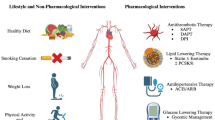Summary
The target values in the treatment of patients with dys- and hyperlipoproteinemia are dependent on the underlying risk factors and the already existing vascular complications, respectively. The target value for patients with manifest vascular complications and for diabetics is <2.6 mmol/l (100 mg/dl) for LDL cholesterol. Results of recent studies show that in these high risk patients the target value for LDL Cholesterol should be ≤1.8 mmol/l (70 mg/dl). Triglycerides should generally be lowered to <1.7 mmol/l (150 mg/dl) and HDL cholesterol should be >1.0 mmol/l (40 mg/dl). In high risk patients even higher HDL levels should be reached (men: >1,2 mmol/l (45 mg/dl), women: >1,4 mmol/l (55 mg/dl)). Basic therapy measurements of hyperlipoproteinemia are changes in diet, reduction of body weight and physical training after exclusion of contraindications. If the goals of therapy cannot be reached with these measures, drug therapy is indicated. In hypercholesterolemia the first choice are statins, which show the best data concerning endpoint studies. Other therapeutic options are ezetimibe, nicotinic acid derivates with retarded release marketed in Germany as Niaspan®, fibrates and in single cases anion exchanger. In patients with hypertriglyceridemia fibrates are effective, but there exist very few endpoint studies for this substance group. Fish oils can also be used in this case. Mixed forms of hyperlipoproteinemia are the most difficult disorders to treat, in these cases the therapeutic decision should depend on whether the hypercholesterolemia or the hypertriglyceridemia is dominating.
Zusammenfassung
Die Zielwerte in der Behandlung von Patienten mit Dys- und Hyperlipoproteinämien richten sich nach den vorliegenden Risikofaktoren bzw. den bereits bestehenden Gefäßkomplikationen. Patienten mit manifesten Gefäßkomplikationen wie auch Diabetiker sind auf LDL-Cholesterin-Zielwerte <2,6 mmol/l (100 mg/dl) einzustellen. Ergebnisse neuer Studien sprechen dafür, bei diesen Hochrisikopatienten LDL-Cholesterin-Zielwerte ≤1,8 mmol/l (70 mg/dl) anzustreben. Die Triglyzeride sollten generell bei <1,7 mmol/l (150 mg/dl) und das HDL-Cholesterin bei >1,0 mmol/l (40 mg/dl) liegen; bei Hochrisikopatienten sind höhere HDL-Werte anzustreben (Männer: >1,2 mmol/l (45 mg/dl), Frauen: >1,4 mmol/l (55 mg/dl)).
Ernährungsumstellung, Gewichtsoptimierung und nach Ausschluss von Kontraindikationen physisches Training sind nach wie vor die basistherapeutischen Maßnahmen in der Behandlung von Fettstoffwechselstörungen. Wenn damit die Therapieziele nicht erreicht werden, ist die Indikation für eine medikamentöse Therapie gegeben. Bei Hypercholesterinämien sind an erster Stelle Statine indiziert; sie verfügen über die beste Datenlage bezüglich Endpunktstudien. Weitere therapeutische Optionen sind Ezetimib, Nikotinsäurederivate, die in verzögerter Form freigesetzt werden und in Deutschland als Niaspan® im Handel sind, und Fibrate sowie in Einzelfällen Anionenaustauscherharze. Bei reinen Hypertriglyzeridämien sind Fibrate wirksam, allerdings liegen nur wenige Endpunktstudien für diese Substanzgruppe vor. Auch Fischöle können zum Einsatz kommen. Gemischtförmige Fettstoffwechselstörungen sind am schwierigsten zu behandeln. Hier sollte die therapeutische Entscheidung davon abhängig gemacht werden, ob die Hypercholesterinämie oder die Hypertriglyzeridämie im Vordergrund steht.
Similar content being viewed by others
References
Cannon CP, Braunwald E, McCabe CH et al (2004) Pravastatin or Atorvastatin Evaluation and Infection Therapy-Thrombolysis in Myocardial Infarction 22 Investigators. Intensive versus moderate lipid lowering with statins after acute coronary syndromes. N Engl J Med 350:1495–1504
Cleeman JI (2001) Expert Panel on Detection, Evaluation, and Treatment of High Blood Cholesterol in Adults (Adult Treatment Panel III): Executive Summary of the Third Report of the National Cholesterin Education Program (NCEP). JAMA 285 19:2486–2497
DIAS (2001) Effect of fenofibrate on progression of coronary-artery disease in type 2 diabetes: the Diabetes Atherosclerosis Intervention Study, a randomised study. Lancet 357:905–910
GISSI-Prevenzione Forschungsgruppe (1999) Nahrungsergänzung mit mehrfach ungesättigten n-3-Fettsäuren und Vitamin E nach Herzinfarkt: Ergebnisse der GISSI-Prevenzione-Studie. Lancet 354:447–455
Gohlke H, Kübler W, Mathes P et al (2001) Empfehlungen zur umfassenden Risikoverringerung für Patienten mit koronarer Herzerkrankung, Gefäßerkrankungen und Diabetes. Z Kardiol 90:148–149
Grundy SM, Vega GL, McGovern ME et al (2002) Efficacy, safety, and tolerability of once-daily niacin for the treatment of dyslipidemia associated with type 2 diabetes; results of the assessment of diabetes control and evaluation of the efficacy of niaspan trial. Arch Intern Med 162:1568–1576
Nissen SE, Tuzcu EM, Schoenhagen P et al (2004) Effect of intensive compared with moderate lipid-lowering therapy on progression of coronary atherosclerosis; a randomized controlled trial. JAMA 291:1071–1080
MRC/BHF Heart Protection Study of cholesterol lowering with simvastatin in 20 536 high-risk individuals; a randomised placebo-controlled trial (HPS) (2002). Lancet 360:7–22
Kluthe R, Fürst P, Hauner H et al (2000) Rationalisierungsschema 2000 des Berufsverbandes Deutscher Ernährungsmediziner (BDEM), der Deutschen Adipositas Gesellschaft, der Deutschen Akademie für Ernährungsmedizin (DAEM), der Deutschen Gesellschaft für Ernährung (DGE), der Deutschen Gesellschaft für Ernährungsmedizin (DGEM) und des Verbandes der Diätassistenten—Deutscher Berufsverband (VDD). Aktuel Ernaehr Med 25:263–270
Shepherd J, Blauw GJ, Murphy BM et al (2002) on behalf of the PROSPER study group: Pravastatin in elderly individuals at risk of vascular disease (PROSPER): a randomised controlled trial. Lancet 360:1623–1630
Author information
Authors and Affiliations
Rights and permissions
About this article
Cite this article
Fischer, S. Risikoadaptierte Therapie von Gefäßerkrankungen—. ZS Kardiologie 94 (Suppl 4), iv24–iv27 (2005). https://doi.org/10.1007/s00392-005-1407-7
Issue Date:
DOI: https://doi.org/10.1007/s00392-005-1407-7




